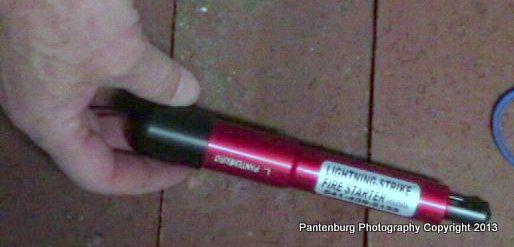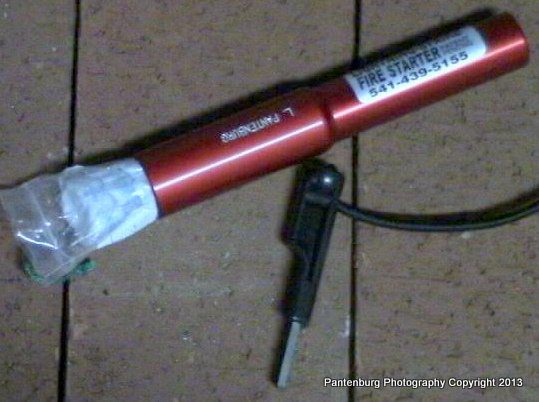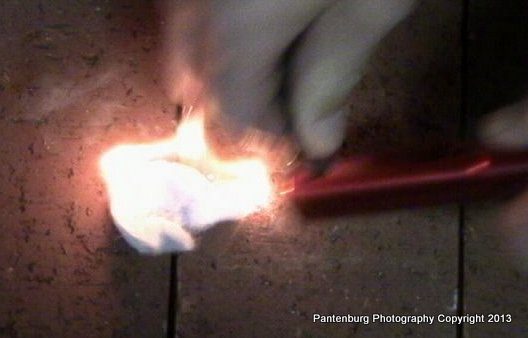Survival Fire Making
The ability to make a fire under emergency conditions may save your life. The inability may cost your life! Here are some proven methods that work!
Tuesday, January 13, 2015
Thursday, December 11, 2014
Tuesday, October 29, 2013
Review: The Lightning-Strike Fire Starter
At the time of this publication, Lightning-Strike Fire Starter is not an advertiser with SurvivalCommonSense.com. I was not reimbursed for this review.
During a backcountry emergency, you may stake your life on your firemaking tools. Here is a system worth considering.
by Leon Pantenburg
It has been well over 12 years, and thousands of fires, since I used anything but traditional flint, steel and charcloth to start a campfire in the wilderness: I enjoy practicing survival skills.
 The Lightning-Strike is compact, portable and contains a complete firemaking system.
The Lightning-Strike is compact, portable and contains a complete firemaking system.As a Boy Scout and community volunteer, I have done extensive research on what survival firemaking tools and techniques work best. In the past 12 years, I have helped teach well over 12,000 scouts, students, outdoorspeople and others the flint and steel technique. In 2007, I received a Boy Scouts Fremont District Award of Merit for the survival firemaking teaching program I designed and helped implement.
The point of this bragging is that I can claim some expertise in survival firemaking. Typically, SurvivalCommonSense doesn't do fire tool reviews, because, many of the "new" products are nothing but re-organized and re-packaged versions of the same old techniques and tools. And it would be really, really hard to improve upon my go-to survival firestarting standard of cotton balls infused with petroleum jelly, ignited with a ferrocerium rod.
So Darrell Holland, inventor of the Lightning-Strike Fire Starter, had a sales job before I would agree to review the product. The product came into existence after Holland and his son, an Eagle Scout decided to come up with a new and improved firestarting tool.
 The Lightning-Strike contains firestarter in the handle, and disassembles to allow the ferrocerium rod to be used with the striker.
The Lightning-Strike contains firestarter in the handle, and disassembles to allow the ferrocerium rod to be used with the striker.Here are the advantages of the Lightning-Strike, according to Holland.
- Completely self-contained: A Lightning-Strike is light (about 8 ounces) compact and easy to pack. It provides everything you need to start an emergency fire.
- Waterproof: The Lightning-Strike Tinder is kept in a waterproof container that also serves as the handle.
- Hotter sparks: The sparks produced by the ferrocerium rod in the unit are between 4,000 and 5,000 degrees, according to the company, and the focused stream makes for better and faster ignition.
- Works in any environmental situation.
If all that was true, then this method did have something new and different.
In my experience, a common problem with survival firestarting is making the transition from ignition to smaller twigs. Generally, most people can light a match or lighter to produce the initial flame. Where they fail is lack of transition time, which would allow the flame to light the twigs or other tinder.
A match may be good for a few seconds of flame, and a lighter for longer. But during nasty, rainy weather, if the wood is wet or damp, that may not be enough time. I always carry emergency firestarter along just because of that. In a survival situation where hypothermia is a possibility, time is critical.
My first impression of the Lightning-Strike out of the box is that it shows quality materials and workmanship. About the size of a mini-maglite, it doesn't take up much room. The ferrocerium rod throws showers of sparks, and it is positioned in a tube that concentrates them. This makes for a much hotter ignition.
 The ferro rod readily ignites the firestarter that is stored in the hollow handle.
The ferro rod readily ignites the firestarter that is stored in the hollow handle.I was amazed - my old reliable ferro rod that I have been carrying for a couple years only appeared to be about half as bright as the Lightning-Strike. I'm assuming this means the Lightning-Strike produces about twice the heat.
A special firestarter comes with the Lightning-Strike, and it is designed to fit in the handle. The material appears to be some sort of petroleum product, that is infused into a cotton (?) pad. The firestarter can be ordered from the company. My thought is to continue carrying a separate container of cotton balls and petroleum jelly, and use that first.
And the system can be used one-handed. All you do is remove the firestarter from the handle, and position it at the end of the tube. Stand on the end of the Lightning-Strike to hold it in place, and scrape the ferro rod with the striker. Fire.
All in all, I really like the Lightning-Strike. It seems eminently practical, and it produces a hot spark stream that lights tinders quite well. The quality workmanship means the product should be reliable, and pretty much foolproof. A Lightning-Strike could be a valuable addition to a bug out bag, daypack or any other emergency/survival kit. This product is a keeper.
Tuesday, June 26, 2012
Review: The Boy Scout Hot Spark ferro rod
The best survival gear doesn't have to be expensive. But it must be reliable and able to work under extreme conditions. One of the best ferrocerium rods for firemaking is the Boy Scout Hot Spark.
by Leon Pantenburg
I like stuff that works. Some of these items include my Cold Steel SRK survival knife, Ruger 10/22, a Swiss Army Classic keychain knife, my Gerber folding saw and a 42-ounce enamelware cup. Included in this list is a Boy Scout Hot Spark ferrocerium rod.
Because of its reliability, a Hot Spark is included in my keyring and Altoid tin survival kits. Backup ferro rods are also scattered throughout my gear. They don't weigh anything, or take up any space, and the ferro rod firemaking technique, properly done is utterly reliable. (Check out the ferro rod firemaking video!)
The Boy Scout Hot Spark on my keyring survival kit costs about three dollars at any scout store. It has a good handle and the ferro rod is very effective. Because it is easily included and convenient, it will be taken along.
Here's why I carry a ferro rod:
 |
| Visit our store! |
by Leon Pantenburg
I like stuff that works. Some of these items include my Cold Steel SRK survival knife, Ruger 10/22, a Swiss Army Classic keychain knife, my Gerber folding saw and a 42-ounce enamelware cup. Included in this list is a Boy Scout Hot Spark ferrocerium rod.
Because of its reliability, a Hot Spark is included in my keyring and Altoid tin survival kits. Backup ferro rods are also scattered throughout my gear. They don't weigh anything, or take up any space, and the ferro rod firemaking technique, properly done is utterly reliable. (Check out the ferro rod firemaking video!)
The Boy Scout Hot Spark on my keyring survival kit costs about three dollars at any scout store. It has a good handle and the ferro rod is very effective. Because it is easily included and convenient, it will be taken along.
Here's why I carry a ferro rod:
- Extreme reliability: A ferrocerium rod, when scraped with a hardened steel striker, will produce sparks with temperatures of up to 5,500 degrees. These sparks will readily ignite many forms of tinder. (Check out the video on finding tinder under survival conditions) A ferro rod is also good for hundreds, if not thousands of fires. Matches, lighters and many other methods are finite.
- Compact and easy to carry: That means you can carry several as backups.
- Work under conditions that would disable other firemaking methods: This is one of the
most important reasons to carry a ferro rod. Butane lighters are easily disabled by cold and moisture or a grain of sand. Matches are unreliable and degenerate over time. Every firemaking method has some disadvantage, but I believe a ferro rod has the fewest.
Saturday, June 9, 2012
The top five reasons to include a ferro rod in your survival kit
The ability to make a fire during an emergency situation can save your life. But what is the best survival firestarting method? My money is on the ferrocerium (also commonly referred to as a flint or magnesium stick) rod. Here are five reasons you need one.
by Leon Pantenburg
Several years, the late Dr. Jim Grenfell and I set out to research the most effective practical firemaking method. After extensive research, the ferro rod, combined with cotton balls and petroleum jelly, came out the winner. (To read the rest of the story, click on the top survival firemaking methods.)
Ferro rods are easy to come by and cheap. The Boy Scout Hot Spark on my keyring survival kit costs about three dollars at any scout store. It has a good handle and the ferro rod is very effective.
Ferro rods are also available at most sporting goods stores. But I'm surprised more outdoorspeople don't include them as part of their survival gear. Here are some things to consider:
 |
| Check out these custom ferro rods! |
by Leon Pantenburg
Several years, the late Dr. Jim Grenfell and I set out to research the most effective practical firemaking method. After extensive research, the ferro rod, combined with cotton balls and petroleum jelly, came out the winner. (To read the rest of the story, click on the top survival firemaking methods.)
Ferro rods are easy to come by and cheap. The Boy Scout Hot Spark on my keyring survival kit costs about three dollars at any scout store. It has a good handle and the ferro rod is very effective.
Ferro rods are also available at most sporting goods stores. But I'm surprised more outdoorspeople don't include them as part of their survival gear. Here are some things to consider:
- Extreme reliability: A ferrocerium rod, when scraped with a hardened steel striker, will produce sparks with temperatures of up to 5,500 degrees. These sparks will readily ignite many forms of tinder. (Check out the video on finding tinder under survival conditions) A ferro rod is also good for hundreds, if not thousands of fires. Matches, lighters and many other methods are finite.
- Compact and easy to carry: I carry a tiny ferro rod in my wallet, another on my keychain, and a third in my survival gear. (Some people might say I obsess about firemaking tools, since I also carry a BIC mini lighter in my pants pocket, my jacket pocket and my pack!) If a survival tool is not compact and easy to carry, it may get left behind. Your only survival tools are those you have along!
- Work under conditions that would disable other firemaking methods:This is one of the
most important reasons to carry a ferro rod. Butane lighters are easily disabled by cold and moisture or a grain of sand. Matches are unreliable and degenerate over time. Every firemaking method has some disadvantage, but I believe a ferro rod has the fewest. - Easy to learn: Every survival technique should be practiced before you rely on it. Making sparks with a ferro stick is easy, but you have to use the correct technique to get a fire started. Check out the video on starting a fire with a ferro stick.
- Wide range of uses: I use my ferro rod as a survival tool, of course, but also use one to light my propane Camp Chef double burner stove, my barbeque grill, backpacking stoves and wood stoves.

Tuesday, November 15, 2011
Book Review: Peter Kummerfeldt's 'A Better Way to Build a Fire'
The ability to build a fire build a fire under survival conditions may save your life. The inability may cost your life!
As a Boy Scout survival skills volunteer, I have helped teach well over 10,000 people basic flint-and-steel firemaking skills. This instruction has been done during all sorts of weather extremes. I have tried and tested many different firemaking methods, with the goal of being able to recommend the right tools to make a firemaking kit that could a person’s life.
One thing I learned after all this research and training is this: The average person, even if given matches and gasoline, couldn’t start a fire under survival conditions! Firemaking, like any survival skill, must be practiced, and you have to start out with the right tools and training.
One of those training tools might be Survival expert Peter Kummerfeldt's new ebook: "A Better Way to Build a Fire." Click here to read the review.
As a Boy Scout survival skills volunteer, I have helped teach well over 10,000 people basic flint-and-steel firemaking skills. This instruction has been done during all sorts of weather extremes. I have tried and tested many different firemaking methods, with the goal of being able to recommend the right tools to make a firemaking kit that could a person’s life.
One thing I learned after all this research and training is this: The average person, even if given matches and gasoline, couldn’t start a fire under survival conditions! Firemaking, like any survival skill, must be practiced, and you have to start out with the right tools and training.
One of those training tools might be Survival expert Peter Kummerfeldt's new ebook: "A Better Way to Build a Fire." Click here to read the review.
Subscribe to:
Posts (Atom)
